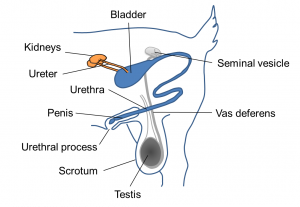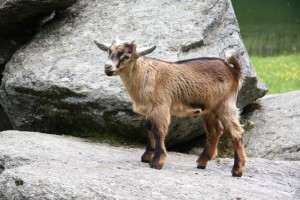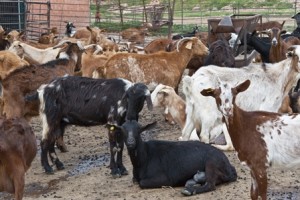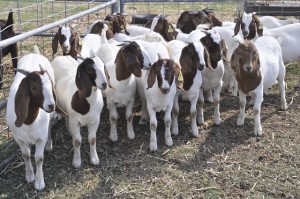Goat Diseases
 Urolithiasis in Goats
Urolithiasis in Goats
Also known as Kidney stones or UTI – Urinary Tract Infection

Male Goat Urinary System. In castrated male goats the narrow urethral process can be undeveloped and a typical site for urinary tract obstructions.
Urolithiasis is a disease in which small calculi (often called ‘stones’ or ‘crystals’) form in the urinary tract and is likely linked to or certainly effected by diet. The goat urinary tract consists of 2 kidneys, the ureters, a bladder and urethra, along which urine flows during urination. Male ruminants have a long narrow urethra which end in the urethral process which is particularly narrow. Fine calculi often form in the urinary system, but are often excreted with the urine; however, in males they can become trapped and block the normal flow of urine (Harwood, 2006).
Urinary calculi or stones are caused by the precipitation of minerals. High levels of minerals tend to crystalise and aggregate in the urine forming calculi (Wang et al., 2009). In goats calculi usually comprise of phosphate salts, especially apatite (calcium phosphate) or more commonly struvite (magnesium ammonium phosphate hexahydrate) (Gutierrez et al., 2000).
Increased urine concentration as a result of decreased water intake, urine stasis and water loss all increase urine pH favouring the formation of phosphate calculi (Gutierrez et al., 2000). However, the diet is considered the most important risk factor associated with urolithiasis.

Castrated male kids are most prone to urolithiasis, but the latter can also be observed in kids that are fattened for meat or pet goats.
The clinical signs of urolithiasis
Young adult male sheep and goats will often strain and bleat with discomfort with urolithiasis and other obstructions of the urinary tract. They sometimes try to kick their abdomens as a sign of discomfort (Hallowell and Potter, 2016).
A detailed physical examination can be very valuable. Male ruminants with urolithiasis will often have dried crystals around the urethral process (see diagram) or in the hair surrounding the prepuce, which will be dry due to an obstruction (Hallowell and Potter, 2016).
As the pressure builds up from the blockage, if undetected, it will eventually rupture the urethra, the goat will rapidly deteriorate and die, hence it is important to detect urinary tract issues early.
Control and Prevention of Urolithiasis
Urolithiasis and water intake

Goats must have access to clean water in order to stay hydrated an avoid an increased urine concentration which is a risk factor for urolithiasis.
If there is a lack of water or the only water available to the goats is contaminated they may not drink what they need, resulting in an increased urine concentration, which leads to a greater risk of mineral precipitation and calculi development (Harwood, 2006).
Urolithiasis and Diet
Diet and animal management are considered important risk factors in the formation of apatite and struvite in ruminants (George et al., 2007). High-concentrate grain diets that have approximately equal proportions of calcium and phosphorus but diets too high in magnesium, potassium and phosphorus are thought to encourage formation of calculi (Wang et al., 2009). Essentially excess dietary magnesium, potassium, phosphorus results in increased urinary excretion of these elements which combine with urinary ammonium to precipitate into highly insoluble calculi (Wang et al., 1997). It is thought that such a process occurs because potassium ions can readily substitute for ammonium ions in the urinary filtrate because of their similar size and electrical charge. It has also been suggested that goats on a low fibre diet may be more susceptible, as saliva production is reduced. As saliva contains high levels of phosphorus, there might be a build up of phosphorus in the body (Harwood, 2006).
Treatment of Urolithiasis
Treatment for urinary obstructions should be undertaken by a vet. If it is a partial blockage your vet may be able to remove the obstruction using spasmolytic drugs or surgically. However in the case of a full obstruction and possible rupture treatment is often disappointing and you vet may well advise euthanasia on welfare grounds (Harwood, 2006).
In 2007, 55 male sheep and goats with obstructive urolithiasis were treated at a clinic in Germany. Researchers found that the highest rate of recovery was observed when urine flow was restored by amputation of the urethral process (Dühlmeier et al., 2007).

Diet is important in preventing urolithiasis. Farmers should avoid any sudden large changes in diet and always feed good palatable forage, and provide plenty of clean water.
Good Practice Based on Current Knowledge
- Ensure adequate water intake at all times. Ensure that the water is clean, all kids can reach the trough, and make sure that there are sufficient containers to allow the goats to drink together
- Feed good palatable forage
- Avoid sudden changes in diet and management
- Feed a well-balanced diet with a 2:1 calcium phosphorus ratio
- Make salt licks available to the goats as these can encourage goats to drink more water
- Observe and check male goats regularly
- Non-producing goats (i.e., pets) should have access to ad lib good quality hay and pasture, thus avoiding the use of concentrate feed


 American English
American English

Comments are closed.